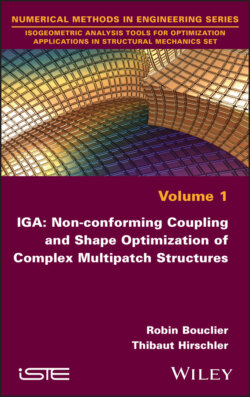Читать книгу IGA - Robin Bouclier - Страница 23
1.2.4.2. Performance
ОглавлениеBeyond the reinforced link between CAD and numerical simulation, IGA turned out to be a superior scientific computing technology. It is now often seen as a high-performance computing method. The reason for this is the higher regularity of spline-based functions that enables us to capture physical solutions with fewer DOF than in standard FEM (Evans et al. 2009). In this respect, IGA has now been successfully applied to numerous disciplines of computational mechanics, such as shell analysis (Kiendl et al. 2009; Echter et al. 2013; Bouclier et al. 2015b), contact problems (Seitz et al. 2016; Antolin et al. 2018), fluid–structure interaction (Kamensky et al. 2017; Apostolatos et al. 2019), biomechanics (Vilanova et al. 2013; Morganti et al. 2015; Patelli et al. 2017), geometrical and material nonlinear solid mechanics (Elguedj et al. 2008; Lipton et al. 2010; Bouclier et al. 2015a; Ambati et al. 2018), fluid dynamics (Bazilevs et al. 2007; Akkerman et al. 2011) and structural vibration (Cottrell et al. 2006; Shojaee et al. 2012), to name a few. In this book, the idea is to benefit from the capabilities of IGA and to arrive at the shape optimization of complex structures, which undoubtedly constitutes one of the most valuable applications for IGA, as both its superior analysis and attractive geometrical properties can magnificently express.
NOTE.– When dealing with the performance of IGA, another important aspect to mention concerns the numerical integration used to evaluate the stiffness operator K (see equation [1.33]). In this work, we proceed, as originally, in IGA, which is the same as in the FEM standard: we perform a classic looping over the knot-span elements, and we take p + 1 Gauss points per element and per parametric direction (with p being the polynomial degree of the shape functions in the corresponding direction). However, we quote that this procedure is not optimal given the higher regularity of the spline functions. Numerous works that aimed to reduce the cost of the construction of isogeometric operators have emerged since the advent of the concept. In this respect, we may cite the development of advanced quadrature rules, more or less related to the entire isogeometric patch (Hughes et al. 2010; Auricchio et al. 2012a; Bouclier et al. 2012; Schillinger et al. 2014; Adam et al. 2015). In the same idea, it may be preferred to focus on collocated-IGA (Auricchio et al. 2010, 2012b) when the polynomial degree is very high. Finally, it was recently noted in the standard Galerkin framework that a revisit of the standard looping over elements in the assembly process could allow IGA to meet its full efficiency (Calabro et al. 2017; Sangalli and Tani 2018; Hiemstra et al. 2019). These innovative implementation techniques are not considered in this work.
